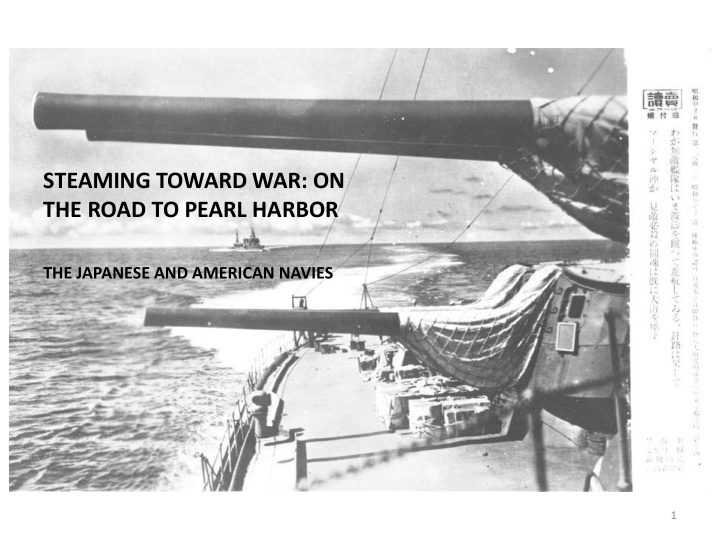



STEAMING TOWARD WAR: ON THE ROAD TO PEARL HARBOR THE JAPANESE AND AMERICAN NAVIES 1
1922: The Washington Treaty Constrains Force Levels Battleship Ratio is 5 to 3 in Favor of the US Navy Battleship Tosa, used as a target in 1924-1925 2
The Two Navies Adapt Battlecruiser Akagi being rebuilt as an aircraft carrier 3
Japanese Naval Strategy: Initially Wait and React to US Move Japanese Operational Approach: Aggressive Defense Based on Cumulative Attrition of US Battleships Japanese Tactical Doctrine: Daytime Submarine Attacks and Night Torpedo Attacks by Cruisers and Destroyers Heavy Cruiser Aoba 4
US Naval Strategy: Offensive, to Blockade Japan US Operational Approach: Aggressive Movement into Japanese Waters to Force an Major Fleet Engagement US Tactical Doctrine: Repel Torpedo Attacks; Maneuver Away from Japanese Night Battle Formations 5
The Clash of Battlefleets: Planned but Not Executed 6
Why Wasn’t It Executed? Air Power. Kaga 1937. 7
TBD-1s on Saratoga 1938. 8
6 IJN Carriers, Nevada at 353 Aircraft Pearl Harbor 9
Learning to Fight: USN Interwar Doctrinal Development Trent Hone @Honer_CUT Trent Hone | @Honer_CUT
The U.S. Navy’s Learning System In the early years of the 20 th century the U.S. Navy developed a sophisticated learning system that led to repeated doctrinal innovations How was this done? Trent Hone | @Honer_CUT
“Planning System” Trent Hone | @Honer_CUT
Interwar Learning Cycles Chief of Naval Operations General Naval War Board College Fleet Command Trent Hone | @Honer_CUT
Annual Cycles of Exercises Trent Hone | @Honer_CUT
Fleet Problems Trent Hone | @Honer_CUT
1919: Principles of War 1. The Objective 7. Movement 2. The Offensive 8. Economy of Force 3. Superiority 9. Cooperation 4. Security 5. Surprise 6. Simplicity Trent Hone | @Honer_CUT
New Tactical Approaches Trent Hone | @Honer_CUT
1930: Vocabulary for Battle Plans Trent Hone | @Honer_CUT
Tactical Heuristics • Aggressive Action to Seize the Initiative • Attack Effectively First – Long Range Gunnery – Carrier Strikes – Night Battle Practice • Decentralized Decision-Making (and Doctrinal Development) Trent Hone | @Honer_CUT
By 1941 … • Learning system is well-established • Doctrine presents a diverse set of options Trent Hone | @Honer_CUT
1942: Carrier Raids Remaining Options Exploited Trent Hone | @Honer_CUT
1942: Guadalcanal Heuristics Prove Effective Trent Hone | @Honer_CUT
1943: Learning System Lessons from First Year of War Exploited Trent Hone | @Honer_CUT
Recommend
More recommend